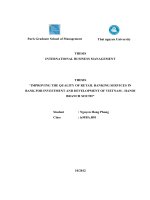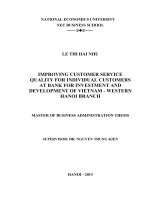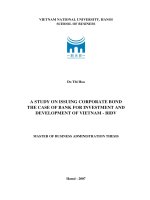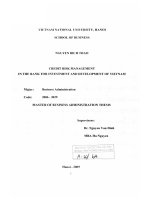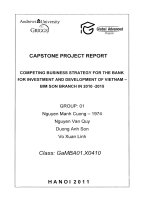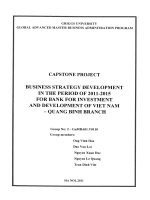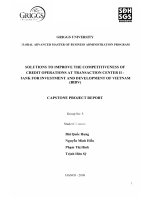What are the factors influencing customer satisfaction at bank for investment and development of vietnam sai gon branch (BIDV sai gon)
Bạn đang xem bản rút gọn của tài liệu. Xem và tải ngay bản đầy đủ của tài liệu tại đây (715.81 KB, 61 trang )
BUSINESS RESEARCH
RESEARCH PROJECT
(BMBR5103)
WHAT ARE THE FACTORS INFLUENCING
CUSTOMER SATISFACTION AT BANK FOR
INVESTMENT AND DEVELOPMENT OF
VIETNAM – SAI GON BRANCH
(BIDV SAI GON) ?
STUDENT’S FULL NAME
: LY TRONG NGUYEN
STUDENT ID
: CGS00019889
INTAKE
: SEPTEMBER, 2015
ADVISOR’S NAME & TITLE
: Dr. BUI PHI HUNG
January, 2017
LY TRONG NGUYEN K19A
Page 1
BUSINESS RESEARCH
Advisor’s assessment
.....................................................................................................................................................................
.....................................................................................................................................................................
.....................................................................................................................................................................
.....................................................................................................................................................................
.....................................................................................................................................................................
.....................................................................................................................................................................
.....................................................................................................................................................................
.....................................................................................................................................................................
.....................................................................................................................................................................
.....................................................................................................................................................................
.....................................................................................................................................................................
.....................................................................................................................................................................
.....................................................................................................................................................................
.....................................................................................................................................................................
.....................................................................................................................................................................
.....................................................................................................................................................................
.....................................................................................................................................................................
.....................................................................................................................................................................
.....................................................................................................................................................................
.....................................................................................................................................................................
.....................................................................................................................................................................
LY TRONG NGUYEN K19A
Page 2
BUSINESS RESEARCH
Contents
CHAPTER 1: INTRODUCTION .............................................................................................................5
1.
Problem statement: ........................................................................................................................5
2.
Research objective: .......................................................................................................................6
3.
Research questions: .......................................................................................................................6
4.
Scope and methodology of research: ............................................................................................6
CHAPTER 2: THEORETICAL FRAMEWORK .....................................................................................8
1.
Customer satisfaction: ...................................................................................................................8
2.
Service quality: .............................................................................................................................9
3.
Service quality and customer satisfaction: ..................................................................................12
4.
Price and the relationship between price and customer satisfaction: ..........................................13
5.
Conceptual framework and hypotheses: .....................................................................................14
CHAPTER 3: RESEARCH DESIGN .....................................................................................................17
1.
Research methodology: ...............................................................................................................17
2.
Data collection method: ..............................................................................................................17
3.
Qualitative research:....................................................................................................................17
4.
Population and sample: ...............................................................................................................19
5.
Sample size: ................................................................................................................................19
6.
Analysis method:.........................................................................................................................20
7.
Quantitative research:..................................................................................................................20
CHAPTER 4: EMPIRICAL RESULTS AND DISCUSSION ...............................................................24
1.
Determinant of customer expectations: .......................................................................................24
2.
The factors affecting customer satisfaction:................................................................................25
2.1 Service quality:........................................................................................................................25
2.2 Price competitiveness: .............................................................................................................26
2.3 Corporate image : .....................................................................................................................26
2.4 Customer satisfaction: ..............................................................................................................27
3.
Analysis of measurement scales: ................................................................................................27
3.1 Cronbach’s alpha.......................................................................................................................27
3.2 Exploratory Factor Analysis (EFA): ........................................................................................32
3.3 Pearson Correlation: .................................................................................................................39
3.4 Multiple Linear Regression: .....................................................................................................43
3.5 Discussion: ...............................................................................................................................50
CHAPTER 5: BIDV SAI GON OVERVIEW ........................................................................................51
LY TRONG NGUYEN K19A
Page 3
BUSINESS RESEARCH
1.
BIDV’s introduction: ..................................................................................................................51
2.
BIDV Sai Gon’s introduction: ....................................................................................................51
CHAPTER 6: CONCLUSION, RECOMMENDATION .......................................................................54
1.
Conclusion: .................................................................................................................................54
2.
Recommendation: .......................................................................................................................54
REFERENCES: ......................................................................................................................................56
APPENDIX 1 ..........................................................................................................................................58
QUESTIONNAIRE ............................................................................................................................58
CUSTOMER SURVEY FORM ......................................................................................................58
LY TRONG NGUYEN K19A
Page 4
BUSINESS RESEARCH
Abstract:
The main objective of this study is to identify all the main factors that influence the
customer satisfaction in banking at the present contemporary global and highly competitive
economy. This research will find out that Corporate image, Tangible, Staff conduct,
Service quality, Price, Credibility, Customer interaction and Convenience are critical
factors influenced customer satisfaction with Corporate image, Tangible, Staff conduct and
Service quality were four hypotheses that had the biggest influence on business customer
satisfaction.
CHAPTER 1: INTRODUCTION
1. Problem statement:
Nowadays the trend of globalization, international and area economic integration is
rapidly developing along with the development of scientific technology and the market
opening. Service quality, service charges, perceived value and customer satisfaction are
the key sources of success in any service factory (Olorunniwo and Hsu, 2006). For many
years customer satisfaction has been a major goal of business organizations, since it has
been deemed to affect customer retention and companies’ market share (Hansemark and
Albinsson, 2004).
Customer’s satisfaction have strong influence on the efficiency and financial
performance of banks (Al-Hawari and Ward, 2006). Customer is factor that decides the
existence of the bank. If bank has the customer’s concern and loyalty, it will win and
develop. Business strategy focuses on consumers is becoming the most important business
strategy. Collaboration with customers in business, attracting new customers and
strengthening existing customers is becoming an effective business tool with a small
amount of additional cost but provides high effective business results. How to bring the
best satisfaction to customers always is the problem that banks have to do with all their
abilities.
Furthermore, customer satisfaction will be useful for creating customer loyalty
which is necessary to maintain regular operations of the bank. The improvement of service
quality, perceived value, and satisfaction ensure customer loyalty (Kuo et al., 2009; Lai et
al., 2009; Wu and Liang, 2009). However, in competition, the creation of customer loyalty
is not sure that customer will stick with bank for long term. Banks need to be proactive in
the maintenance and development of relationships between customers and banks.
LY TRONG NGUYEN K19A
Page 5
BUSINESS RESEARCH
Therefore, study customer satisfaction in banking sector is an important work, has
to be done regularly and continuously to be able to respond promptly to the changes in
customer demand, make them satisfy when using the services and products of bank.
2. Research objective:
-
Investigate the factors affecting customer satisfaction.
-
Recommend solutions to improve customer satisfaction to BIDV Sai Gon’s
services and products.
3. Research questions:
-
Are customers satisfied with the products and services and quality of service BIDV
Sai Gon or not?
-
What are factors that affect business customer satisfaction for quality of
products/services provided at BIDV Sai Gon?
-
What solutions can help improve business customer satisfaction for banking
product and service quality at BIDV Sai Gon in the future?
4. Scope and methodology of research:
4.1
-
Scope of research:
The research project on the factors influencing the customer satisfaction at the
Bank For Investment and Development of Vietnam, JSC – Sai Gon Banch.
-
The research project is based on primary data and secondary from 2012 to 2014,
focusing primarily on the factors related to customer satisfaction for banking product and
service quality at BIDV Sai Gon.
-
Subjects of study are business customers, not individual customers.
4.2 Limitation of research:
-
Subjects of study are business customers with its own characteristics on demand
service, criteria for evaluating service quality and perceiving price services to business
customers, so research results can not response used simultaneously to all customers.
-
Research scope limited to customers using the service at BIDV Sai Gon in Ho Chi
Minh city area should not be assessed on overall customer groups in different local and
potential customers may not use bank service.
-
Study looks at just the time and number of bank customers use, not understanding
customer satisfaction in relation to business, financial resources and ethnic factors.
LY TRONG NGUYEN K19A
Page 6
BUSINESS RESEARCH
4.3 Structure of thesis:
-
Chapter 1: Introduction
-
Chapter 2: Theoretical framework
-
Chapter 3: Research design
-
Chapter 4: Empirical result and discussion
-
Chapter 5: BIDV Sai Gon Overview
-
Chapter 6: Conclusion and recommendation
LY TRONG NGUYEN K19A
Page 7
BUSINESS RESEARCH
CHAPTER 2: THEORETICAL FRAMEWORK
1. Customer satisfaction:
Customer satisfaction involves determining the degree to which a company’s
products or services meets the requirements of the customer as an end user.
Pairot (2008) defined Customers satisfaction as the company's ability to fulfill the
business, emotional, and psychological needs of its customers. In the words of Oliver
(1981, p.27), customer satisfaction is “the summary psychological state resulting when the
emotion surrounding disconfirmed expectations is coupled with the consumer s prior
feelings about the consumption experience.” Customer satisfaction has also been defined
by Hunt (1977, p.459) as “an evaluation rendered that the (consumption) experience was at
least as good as it was supposed to be.” Furthermore, Engel and Blackwell (1982, p.501)
have opined it to be “an evaluation that the chosen alternative is consistent with prior
beliefs with respect to that alternative.” It is a well-researched fact that investments in
customer satisfaction, customer relationships and service quality leads to profitability and
market share Rust and Zahorik (1993). Put differently, customer satisfaction leads to
customer loyalty and this also leads to profitability Hallowell (1996). If customers are
satisfied with a particular high quality service offering after its use, then they can be
expected to engage in repeat purchase and even try line extensions and thus market share
can be improved.
Levesque and McDougall (1996) have empirically confirmed and reinforced the
notion that consistent poor customer experience leads to a decrease in the levels of
customer satisfaction and the chances of further willingness to recommend the service (i.e.,
word-of-mouth advertising or referrals) is lessened. Previous researches have shown strong
linkages between service quality dimensions and overall customer satisfaction (Anderson
and Sullivan (1993)). Service quality is accepted as one of the basic factors of customer
satisfaction (Parasuraman et al., (1994)). However, there is much debate whether customer
satisfaction is a precursor of service quality judgements (Parasuraman et al., (1985) and
Bitner et al., (1990)) or the other way round (Anderson and Sullivan, (1993)). Definitive
analysis has showed that service quality cannot be divorced from the concept of customer
satisfaction. Recent studies have shown that satisfaction is influenced by not only
perceptions of service quality but also by perceptions of product quality, and pricing
factors as well as situational and personal factors (Zeithaml and Bitner, (2000)). For
LY TRONG NGUYEN K19A
Page 8
BUSINESS RESEARCH
example, customer satisfaction with retail banking will be a broader concept and will
certainly be influenced by perceptions of service quality but will also include perceptions
of product quality (such as variety of deposit options available to customers), price of the
products(i.e., charges charged by the bank or rates offered by the banks on various
deposits), personal factors such as the consumer s emotional state, and even uncontrollable
situational factors such as weather conditions and experiences in conveying to and from
the bank.
2. Service quality:
2.1 Concept of service quality
For a long time, many researchers have tried to define and measure service quality.
For example, Lehtinen & Lehtinen (1982) mentioned that the quality of service must be
judged on two aspects, (1) the process of service provider and (2) the results of the service.
Grönroos (1984) also suggested that the two components of service quality are (1)
technical quality, which is what customers receive and (2) functional quality, which
interpret how services are provided. According to Hubert (1995), before using the service,
customers have formed a "script" on that service. When screenplays of customers and
suppliers are not identical, customers will feel dissatisfied. Cronin and Tailor (1992)
suggested that customer satisfaction should be reviewed in short time, and the service
quality should be reviewed by the attitudes of customers for that service in a long time.
However, when it comes to service quality, we can not fail to mention the huge
contribution of Parasuraman et al., (1988, 1991). Parasuraman et al., (1988, page 17)
defines service quality as the difference between the consumers’ expectations of services
and their perceptions of the service’s outcome.
2.2 Service quality measurement
2.2.1 SERVQUAL Model
Service quality is measured by a variety of factors and accurately identifying these
elements depends on the nature of services and research environment. There are many
authors have studied this issue, but the most popular and best known is the service
quality’s review criteria of Parasuraman et al.
In 1985, Parasuraman et al. gave 10 decisive factors of service quality which are
listed below:
1. Accessibility
LY TRONG NGUYEN K19A
Page 9
BUSINESS RESEARCH
2. Quality of communication
3. Competence
4. Courtesy
5. Credibility
6. Reliability
7. Responsiveness
8. Security
9. Tangibles
10. Understanding the customers
In 1988, these authors initiated and used the qualitative and quantitative research to
build and test the scale of service quality’s components (SERVQUAL scale). SERVQUAL
scale was adjusted and tested in many different types of services. SERVQUAL model was
built based on the perceived standpoint of service quality as a comparison between the
expected values/expectations and value which customer received. SERVQUAL consider
two aspects of service quality is service result and service process which were studied
through 22 scales of 5 criteria: reliability, responsiveness, assurance, tangibles and
empathy.
a. Reliability
Trust is the ability to provide service accurately, on time and reputably. This
requires consistency in the implementation of services and commitment as well as keeps
the promise to the customer.
b. Responsiveness
This criterion measures the ability to solve problems quickly, handle complaints
effectively, ready to help customers and satisfy the requirements of customers. In other
words, responsiveness is the feedback from service providers with what customers want.
c. Assurance
This is the factor that makes up trust for customers which is perceived through
good Service quality service, technical knowledge, courtesy and social skills. So that
customers will feel assurance when using service of provider.
d. Tangibles
LY TRONG NGUYEN K19A
Page 10
BUSINESS RESEARCH
Tangibles are reflection outside of the physical facilities, equipment, machinery,
staffs’demeanour, documentation, manuals and information systems of service provider. In
general, what all customers are directly visible to the eye and the senses can impact factors.
e. Empathy
Empathy is the considerable concern, care for customers, give them the most
attentive treatment in order to make customer feel being always warmly welcomed. Human
is core part to make up the success of this factor and the more provider cares customers,
the more empathy if customers increases.
2.2.2. SERVPERF Model
Two authors Cronin and Taylor (1992) have adjusted SERVQUAL scale into
SERVPERF scale. They said that the evaluation of customers’ perceive for services is
more important than the evaluation of customer expectations. SERVPERF scale has only
one group of survey questions about the customers’ awareness of the services which they
received from providers.
2.2.3. FSQ and TSQ Model
According to Grönroos (1984), service quality is reviewed based on two criteria:
functional service quality (FSQ) and technical service quality (TSQ) and service quality is
strongly affected by corporate image. As a result, Grönroos gave 3 factors affecting service
quality are functional service quality, technical service quality and corporate image (called
FTSQ Model).
a. Technical service quality
It is the quality which customers received through access to providers and is
perceived important for customers. In other words, technical service quality is the result of
the interaction between providers and customers in which enterprises provider service and
the customers receive this service. There are 5 criteria to evaluate this factor:
Problem-solving skills
Service quality Skills
Operational proficiency
Modern equipment
Information storage system
b. Functional service quality
LY TRONG NGUYEN K19A
Page 11
BUSINESS RESEARCH
Functional service quality represents the service implementation process and
reflects how services are provided. In the relationship between the two quality’s aspects,
functional service quality plays a more important role which is represented through 7
following criteria:
Convenience in transaction
Behaviors
Service attitude
Organizations of business enterprise
Customer contact
Courtesy
Spirit of all for customers
c. Corporate image
Corporate image is construed as general impression of customers about enterprises,
under which, if the enterprises create a good image in the customer's mind, they easily
bypass these deficiencies occur during service using. Grönroos (1984) also showed that
corporate image was invaluable assets of enterprises and had a positive impact to the
customers’ evaluation about service quality, product value and their satisfaction.
Moreover, corporate image make customers more trust enterprises and become
loyal customers of enterprises (Andreassen and Lindestand, 1998). As a result, the
corporate image has an impact on service quality and customer satisfaction. It is
noteworthy that, customers who often use the services of the enterprises will have more
accurate feeling than other customers (Johnson, Fornell, Andreassen, Lervik and Cha,
2001).
Corporate image is seen as filter device to help the relationship between customers
and enterprises better and more sustainable. Additionally, customers evaluate corporate
image good or bad through their feeling for enterprises and compare corporate image with
other competitors. However, the influence level, more or less, depends on the specific
enterprise.
3. Service quality and customer satisfaction:
According to Spreng and Mackory (1996), service quality and customer satisfaction
are inarguably the two concepts that are so difficult to explain in marketing theory and
LY TRONG NGUYEN K19A
Page 12
BUSINESS RESEARCH
practice. In 2001, Yang argued that when comparing the performance of a product or
service with their expectations before purchasing, if it exceeds the expectation, the
satisfaction of customers would be increased. However, four years later, Saha and Zhoa
(2005) gave out a new definition of satisfaction like “a collective outcome of perception,
evaluation and psychological reactions to the consumption experience with a product or
service”.
The appraisal-emotional response-coping attitudinal framework of Bagozzi (1988)
thought that service quality is a construct oriented to awareness, while satisfaction is an
emotional construct. It is the reason that many researchers suggested service quality is an
antecedent of satisfaction. After that, in 2003, Woldfinbarger and Gilly discovered a
positive relationship between overall service quality and satisfaction in case of fixed web
retailing; also, Montoya-Weiss et al. found out an evidence to prove the relationship
between service quality and satisfaction by analyzing the determinants of online channel
preference for a multichannel service provider.
4. Price and the relationship between price and customer satisfaction:
Price which is showing form by the currency of goods value and services is
determined based on the value of the usage and feeling of the customers on products, or
services that they use. Customer does not have to buy products and services with the
highest quality; they will buy these products and services that make them satisfaction most.
Therefore, factors such as customer perception of price and cost (usage cost) will not affect
the quality of services, but will impact on customer satisfaction (Cronin and Taylor, 1992).
In many previous studies on customer satisfaction, the impact of price factor
received little attention compared to other criteria (Voss et al., 1998). However, with the
increasingly strong competition of the market and changes in customers’ cognizance on
products and services, researchers have determined that price and customer satisfaction
have strong relationship (Patterson et al., 1997). Therefore, if not mention to this factor, the
study of customer satisfaction will lack accuracy.
When buying products or services, customers would have to pay a cost to reclaim
the usage value which they need. As a result, the cost then is called exchange price in order
to have desired value from products and services. Only when the perceived service quality
which customers get is more than usage cost, price will be considered competitiveness and
customers will be satisfied. Conversely, customers will dissatisfy because they feel that
LY TRONG NGUYEN K19A
Page 13
BUSINESS RESEARCH
they have to pay more than what they receive and the price in this case will impact
negatively on customer satisfaction.
This is the relationship among price, value and perceived price. However,
perceived price is the factor affecting customer satisfaction. Maybe the price is more than
the received value, but customers feel reasonable, they still satisfy and vice versa. In the
study of the relationship between perceived price and customer satisfaction, Varki and
Colgate (2001) also demonstrated that these two factors interact with each other and
depend on the customer's sensitivity to price as well as the relationship between the service
user and the service provider. In addition, to evaluate the impact of pricing factors to
customer satisfaction, we need to consider more fully in the three following aspects
(Maythew and Winer, 1982):
Price compared with quality
Price compared with competitors
Price compared with customers’ expectations
Therefore, when considering the impact of price on customer satisfaction we need
to recognize more fully that the price here include the costs and opportunity costs to get
products and services as well as correlation of the price with the aspects mentioned above.
Within the scope of this research, the price factor is considered as the competitiveness of
perceived price. If customers perceive the higher competitiveness of price, the more they
satisfy and vice versa.
5. Conceptual framework and hypotheses:
5.1 Theorical model
SERVQUAL is popular model and widely used in marketing research. This model
is useful in generalizing criteria that measure the service quality but it has many
disadvantages (Babakus & Boller, 1992; Brown et al., 1993; Buttle, 1996; Genestre &
Herbig, 1996; Gilmore & Carson, 1992; Robinson, 1999; Hemmasi et al., 1994) and, if it is
applied strictly to measure the quality of banking services, it will not appropriate in the
following aspects:
Measurement criteria are general
Focus more on measuring providing process than services implementation
results.
LY TRONG NGUYEN K19A
Page 14
BUSINESS RESEARCH
Comparation the distance between quality expectations and perceived quality
is difficult to determine because of considering many scales and not be determined
directly based on actual service performance.
Therefore, measurement criteria of SERVQUAL can not be applied in all areas. It
must be adjusted to suit with each case study to ensure high accuracy. SERVPERF model
is based on SERVQUAL but more focus on quality of service performance and also
includes 5 criteria as mentioned above (reliability, responsiveness, assurance, tangibles and
empathy). So, it is also not selected as a research model.
For research on customer satisfaction in the banking sector, model of technical
quality and functional quality of Grönroos is more affordable (Lassar et al., 1998), by the
following reasons:
Firstly, FTQS model focuses on two key aspects of service quality is the functional
quality (how enterprise provide its service) and technical quality (which services enterprise
provide). Bank is sector which requires communication, constant communication between
customers and bank employees so the implementation process would be particularly
important for customers in evaluating service quality. Meanwhile SERVQUAL model did
not analysis how bank provide service and which service bank provides.
Secondly, as banks also offer similar services and fewer errors occur, the customer
will pay more attention to the process of service implementing to evaluate service quality
of bank. For the deployment of advanced services for customers, functional quality factor
becomes increasingly more important because it affirms the level of services provider and
marks differences between enterprise and other competitors.
Thirdly, some measurement criteria of SERVQUAL model are also considered in
FTSQ model through research scales and useful for analyzing service quality feasibly and
more affordably.
From the above advantages and disadvantages, author will refer FTSQ and
SERVQUAL model for this research. When bulding up the model, the authors still
consider the key factor impact on customer satisfaction is the service quality (6 factors:
Convenience, Tangibles, Staff Conduct, Service Portfolios, Customer Interaction,
Credibility) followed by the Price Competitiveness and final is Corporate Image.
LY TRONG NGUYEN K19A
Page 15
BUSINESS RESEARCH
Figure 1: Theorical model
5.2 Hypotheses:
-
Hypothesis 1: Convenience has positive impact on customer satisfaction.
-
Hypothesis 2: Tangibles has positive impact on customer satisfaction.
-
Hypothesis 3: Staff conduct has positive impact on customer satisfaction.
-
Hypothesis 4: Service portfolio has positive impact on customer satisfaction.
-
Hypothesis 5: Customer interaction has positive impact on customer satisfaction.
-
Hypothesis 6: Credibility has positive impact on customer satisfaction.
-
Hypothesis 7: Price competitiveness has positive impact on customer satisfaction.
-
Hypothesis 8: Corporate image has positive impact on customer satisfaction.
LY TRONG NGUYEN K19A
Page 16
BUSINESS RESEARCH
CHAPTER 3: RESEARCH DESIGN
1. Research methodology:
The main objective of this study is to identify all the main factors that influence
business customer satisfaction at BIDV Sai Gon. To do research on customer satisfaction
at BIDV Sai Gon, the author will combine qualitative and quantitative research by studying
the literature review and case studies on customer satisfaction. Additionally, the activities
policy of banks, the relationship between research and other factors will also be considered
in an objective manner and synchronized to achieve precise and practical research results.
2. Data collection method:
a. Primary source:
-
Interviews, discussions with staff/banking leaders to better understand the
viewpoints and plans as well as their review about research problems.
-
Questionnaires received from customers. The questionnaires will be sent to all the
business customers through transaction offices of BIDV Sai Gon in Ho Chi Minh city.
b. Secondary source:
-
Secondary information sources will be collected through:
-
Banking magazines, newspapers
-
Marketing magazines, newspapers
-
Research articles about services and service quality
-
Activity reports of BIDV Sai Gon
-
Internet
3. Qualitative research:
This is a preliminary study to screen the variables included in the model study,
examination of the scale used, refer to the comments from banks and customers about
research problems, thereby building scale studies included in the model and set the
questionnaire.
First, the author will prepare some questions for discussion, exchange of staff and
bank management with content focused on research issues:
-
Bank assessment of satisfied customers how to banking products and services.
-
Bank of comments about service quality model in banking sector.
-
Bank has comments about the service quality benchmarks.
-
Bank has an opinion about the expectations of customers in the future.
LY TRONG NGUYEN K19A
Page 17
BUSINESS RESEARCH
-
The scale of customer satisfaction is not fair presentation.
-
Banks use the scale to measure the level of customer satisfaction.
-
How to bring satisfaction to our customers.
On the client side, the authors randomly selected 10 customers to participate in
direct interview, which recorded their opinions about banking services and their
expectations for the bank.
After conducting qualitative research, 8 factors of the model study of customer
satisfaction can be used for further research is quantitative study, 3 criterias for measuring
the level of customer satisfaction.
Variable
Convenience
Indicators
1. Convenient transaction location
2. Wide agent network
3. Easy and quick transaction procedure
Tangibles
1. Modern equipment and technology
2. Attractive posters, brochures, leaflet, handouts…
3. Clear and easy-understood transaction documents
4. Well dressed and Service quality
Staff conduct
1. Great interests in solving the customers’ complaints
2. Well-trained with high competence
3. Accurate and timely service implementation
4. Always available for the services
5. Polite and consistently courteous with customers
Service portfolios
1. Rich and diversified service portfolio
2. Always provide new services to satisfy the customers’
demands
Customer interaction
1. Usually contact and visit customers
2. Having hotline 24/24
3. Holding annual meeting to show appreciation for
customers’ contribution
4. Consider customers’ rights as its prime concern
LY TRONG NGUYEN K19A
Page 18
BUSINESS RESEARCH
Credibility
1. Ensure customers’ information and transaction
confidentially
2. Regular and timely transaction statement delivery
3. Right service implementation at the first time
Price competitiveness
1. Flexible pricing policies
2. Competitive interest rate
3. Reasonable transaction fees
Corporate image
1. Always honor commitment to customers
2. Having great innovation and social contribution
3. Launching effecttive and efficient marketing activities
4. Having right stratefy for sustainable development
Customer satisfaction
1. Satisfaction level of customers with the service quality
2. Ability to meet the customers’ demands
3. Continue using services
4. Population and sample:
All of business customer at BIDV Sai Gon are the population of this study.
5. Sample size:
According to DeCoster, J. (2004), minimum sample size used in statistic analysis
should be is equal to or greater than five times of the number of variables, but not less than
100 to generate reliable results:
n >= 100 and n >= 5k (where k is the number of variables)
This research has 28 variables, as a result, the minimum sample size required to run
EFA in this research is:
n = 5 x 28 = 140
Otherwise, Tabachnick & Fidell (2001) stated that the minimum sample size in
case of multiple regression should be:
n = 50+8m (where m is the number of independent variables)
Apply this formula for 8 independent variables of this research, we have the
minimum sample size for multiple regression as follow:
n = 50 + 8 x 8 = 114
LY TRONG NGUYEN K19A
Page 19
BUSINESS RESEARCH
Summarily, with 28 variables and 8 independent variables, this research needs 140
samples at least to take EFA and regression. Hence, 200 surveys were distributed to target
respondents to take the data for analysis.
6. Analysis method:
Collected data will be processed through using SPSS version 16.0 analytics tool.
7. Quantitative research:
7.1 Objective:
Quantitative research was conducted to test the scale of the research model. This is
a detailed analysis of collected data through questionnaires which are sent to the client to
determine the logical correlation of these factors together and then give specific results of
these research.
7.2 Process research:
a. Construction questionnaire
b. Determine the number of samples needed for research
c. Send to customer surveys
d. Contact the client to monitor the response
e. Get feedback from customers
f. Data processing through the use of SPSS analysis tools in the following order:
Descriptive Analysis
Analysis of the reliability of the scales
Factors analysis
Building integrated research model
Testing of the model through Pearson analysis, regression analysis and
ANOVA analysis
7.3 Result:
One of the forms of measurement which is the most used in quantitative research is
Rennis Likert scale . Rennis Likert introduced scale with 5 levels from 1-5 to assess to
what extent the respondents. Normally, we will use the multi-aspect scale and simple
aspect scale to set up scales and build up questionnaires.
LY TRONG NGUYEN K19A
Page 20
BUSINESS RESEARCH
There are 200 questionnaires sent to business customers selected on the basis of
data banks and regional evenly distributed in the following forms: email (50) and for
arrivals transactions at the bank (150) with the support of the department: customer
service, payment card service, international payments, individual customer management.
There were 154 questionnaires were collected (32 votes by mail, 122 votes from
transaction counters) with response rates of 77%, while 8 votes were rejected due to
invalid. Therefore, the remaining number of samples to be analyzed 146 votes.
Research model of this thesis consists of 8 independent variables of 28 variables.
Therefore, the sample size required is 140 or more. The number of samples used in the
study was 146 samples that should be representative of the sample is guaranteed to
research performance.
Thus, after the number of samples are colllected, the author will use the SPSS 16 to
analyse the data and the variables will be encoded in the table below:
No
Encode
Describle
Convenience (STT)
1
STT01
Convenient transaction location
2
STT02
Wide agent network
3
STT03
Easy and quick transaction procedure
Tangibles (SHH)
4
SHH01
Modern equipment and technology
5
SHH02
Attractive posters, brochures, leaflet, handouts…
6
SHH03
Clear and easy-understood transaction documents
7
SHH04
Well dressed and Service quality
Staff conduct (PCPV)
8
PCPV01
Great interests in solving the customers’ complaints
9
PCPV02
Well-trained with high competence
10
PCPV03
Accurate and timely service implementation
LY TRONG NGUYEN K19A
Page 21
BUSINESS RESEARCH
11
PCPV04
Always available for the services
12
PCPV05
Polite and consistently courteous with customers
Service portfolios (DMSP)
13
DMSP01
Rich and diversified service portfolio
14
DMSP02
Always provide new services to satisfy the customers’ demands
Customer interaction (CSKH)
15
CSKH01
Usually contact and visit customers
16
CSKH02
Having hotline 24/24
17
CSKH03
Holding annual meeting to show appreciation for customers’ contribution
18
CSKH04
Consider customers’ rights as its prime concern
Credibility (STC)
19
STC01
Ensure customers’ information and transaction confidentially
20
STC02
Regular and timely transaction statement delivery
21
STC03
Right service implementation at the first time
Price competitiveness (TCTG)
22
TCTG01
Flexible pricing policies
23
TCTG02
Competitive interest rate
24
TCTG03
Reasonable transaction fees
Corporate image (HADN)
25
HADN01
Always honor commitment to customers
26
HADN02
Having great innovation and social contribution
27
HADN03
Launching effecttive and efficient marketing activities
28
HADN04
Having right stratefy for sustainable development
Customer satisfaction (SHL)
LY TRONG NGUYEN K19A
Page 22
BUSINESS RESEARCH
29
SHL01
Satisfaction level of customers with the service quality
30
SHL02
Ability to meet the customers’ demands
31
SHL03
Continue using services
7.4 Questionnaire design:
a. Objectives:
-
Study customer’expectation for banking service at BIDV Sai Gon
-
Scale customer satisfaction
-
Test the factors influencing customer satisfaction
-
Determine correlation between time of using banking service and number of
transaction bank and customer satisfaction.
b. Structure of questionnaire:
Questionnaire is designed by 5 parts with 02 scales of customer information, 10 scales
of customer expectation, 28 scales of factors affecting customer satisfaction, 3 scales of
determining level of customer satisfaction and customer recommendation. (Appendix 1)
-
Part 1: Customer information
+ Question 1: Time of using banking service
+ Question 2: Number of transaction bank
-
Part 2: Customer expectation
-
Part 3: Factors affecting customer satisfaction
-
Part 4: Customer satisfaction level
+ Question 1: Overal banking service
+ Question 2: Capacity to meet customer demandes
+ Question 3: Continue to use banking service
-
Part 5: Customer recommendation
LY TRONG NGUYEN K19A
Page 23
BUSINESS RESEARCH
CHAPTER 4: EMPIRICAL RESULTS AND DISCUSSION
1. Determinant of customer expectations:
Result in Figure 4.1 shown 3 criteria that customers expect most of the banks in
order: STT03_Easy and quick transaction procedure (Mean: 1.81); PCPV01_Great
interests in solving the customers’ complaints (Mean: 1.99); (3): TCTG03_Reasonable
transaction fees (Mean: 2.97). When data analysed , the most favorite expectations is
measured on a scale from 1 to 3, and the others are 4. The results (Figure 4.1) shows that
most customers expect from the bank is the Service quality service and reasonable prices
as well as the general trend of the market that is reached will now occupy the position
certain competitive.
Figure 4.1: Descriptive Statistics Of Customer Expectation
N
Minimum
Maximum
Mean
Std. Deviation
STT03
146
1
4
1.81
.956
PCPV01
146
1
4
1.99
1.003
TCTG03
146
1
4
2.97
.747
STT02
146
1
4
3.81
.688
PCPV02
146
1
4
3.85
.579
PCPV03
146
1
4
3.91
.406
HADN01
146
1
4
3.92
.398
SHH03
146
2
4
3.93
.325
DMSP01
146
2
4
3.95
.257
SHH01
146
2
4
3.97
.202
Valid N (listwise)
146
LY TRONG NGUYEN K19A
Page 24
BUSINESS RESEARCH
2. The factors affecting customer satisfaction:
2.1 Service quality:
As shown in Figure 4.2.1, in 21 variables of service quality, there are 6 variables
agreed by most customers: PCPV01_ Great interests in solving the customers’ complaints
(Mean: 4.01); STT03_ Easy and quick transaction procedure (Mean: 3.95); PCPV02_Welltrained with high competence (Mean: 3.94); STC01_ Ensure customers’ information and
transaction confidentially (Mean: 3.86), DMSP01_ Rich and diversified service portfolio
(Mean: 3.84): DMSP02_ Always provide new services to satisfy the customers’ demands
(Mean: 3.82).
However, in Figure 4.2.1 also showns the level of customer agrees are not the same
in the observed variables. Five variables agreed at the lowest mean score: SHH01_ Modern
equipment and technology (Mean: 3.18); STT01_Convenient transaction location (Mean:
3.24); SHH03_Clear and easy-understood transaction documents (Mean: 3.26); SHH04_
Well dressed and Service quality (Mean: 3.27); and STT02_ Wide agent network (Mean:
3.40).
Figure 4.2.1: Descriptive Statistics Of Service Quality
N
Minimum
Maximum
Mean
Std. Deviation
PCPV01
146
3
5
4.01
.455
STT03
146
2
5
3.95
.542
PCPV02
146
3
5
3.94
.357
STC01
146
3
4
3.86
.352
DMSP01
146
3
4
3.84
.366
DMSP02
146
3
4
3.82
.384
CSKH04
146
3
5
3.81
.412
STC03
146
3
4
3.78
.415
PCPV03
146
3
4
3.78
.415
STC02
146
2
4
3.75
.463
PCPV05
146
1
5
3.75
.582
PCPV04
146
3
4
3.75
.436
SHH02
146
2
5
3.74
.611
CSKH02
146
3
4
3.59
.494
LY TRONG NGUYEN K19A
Page 25
